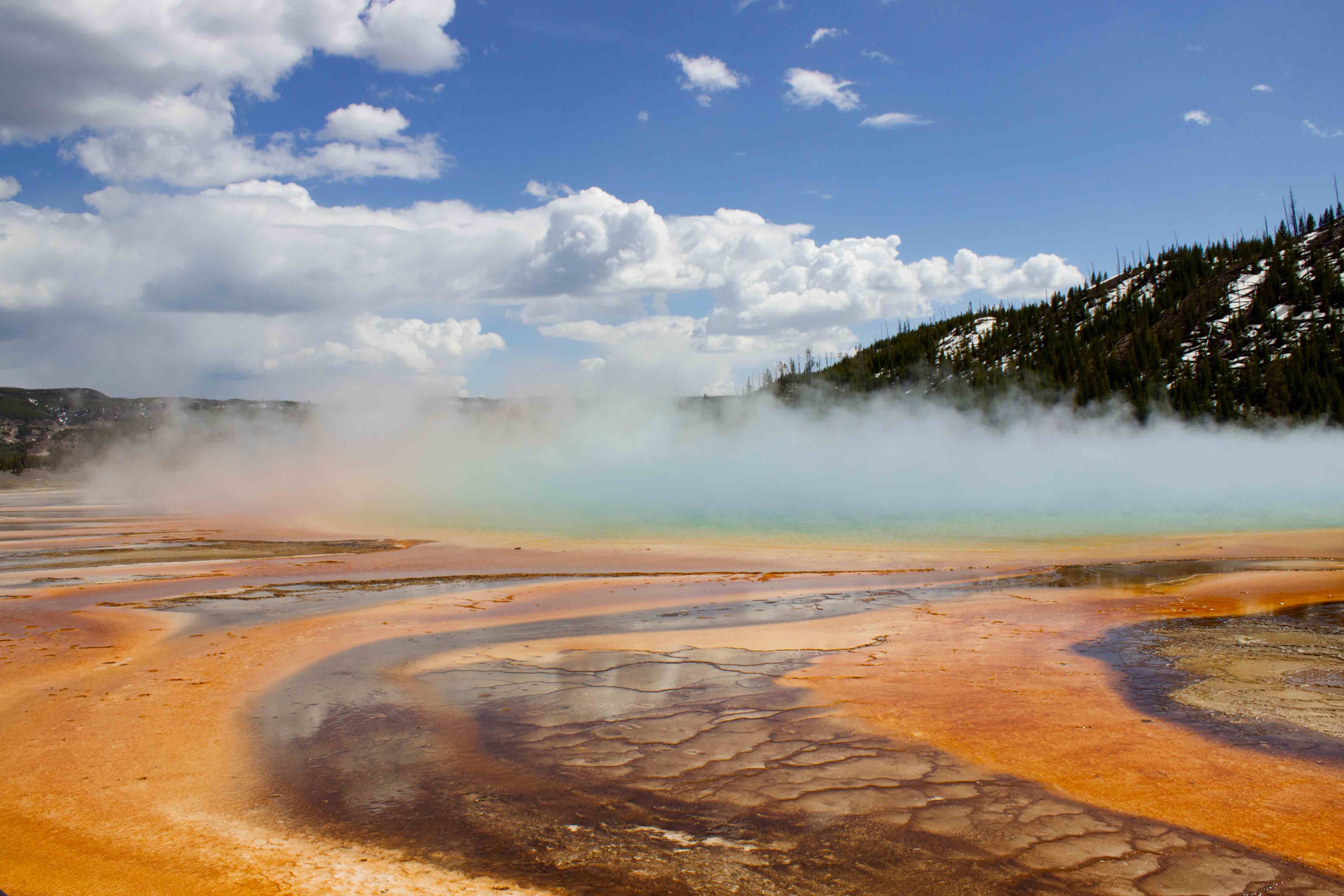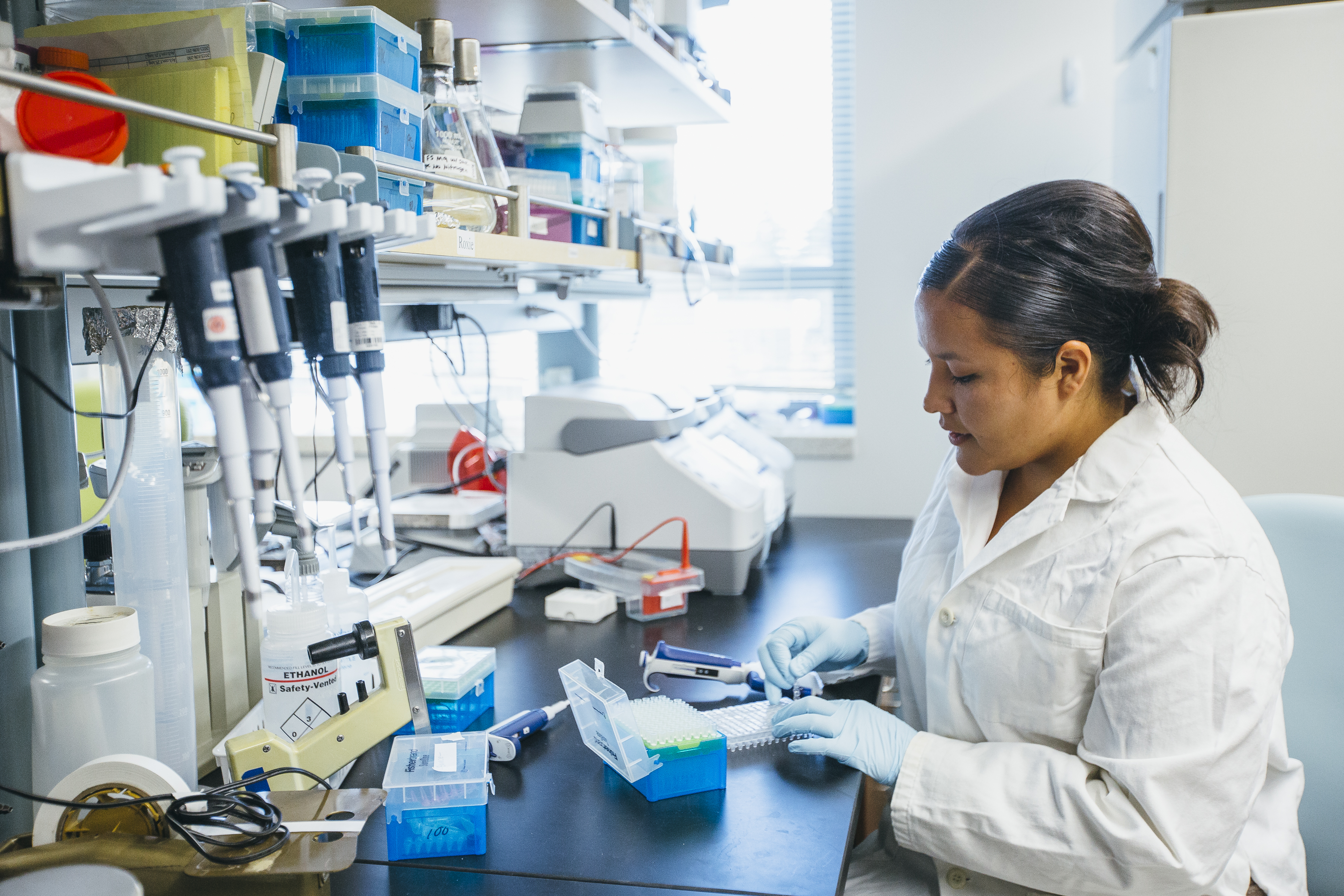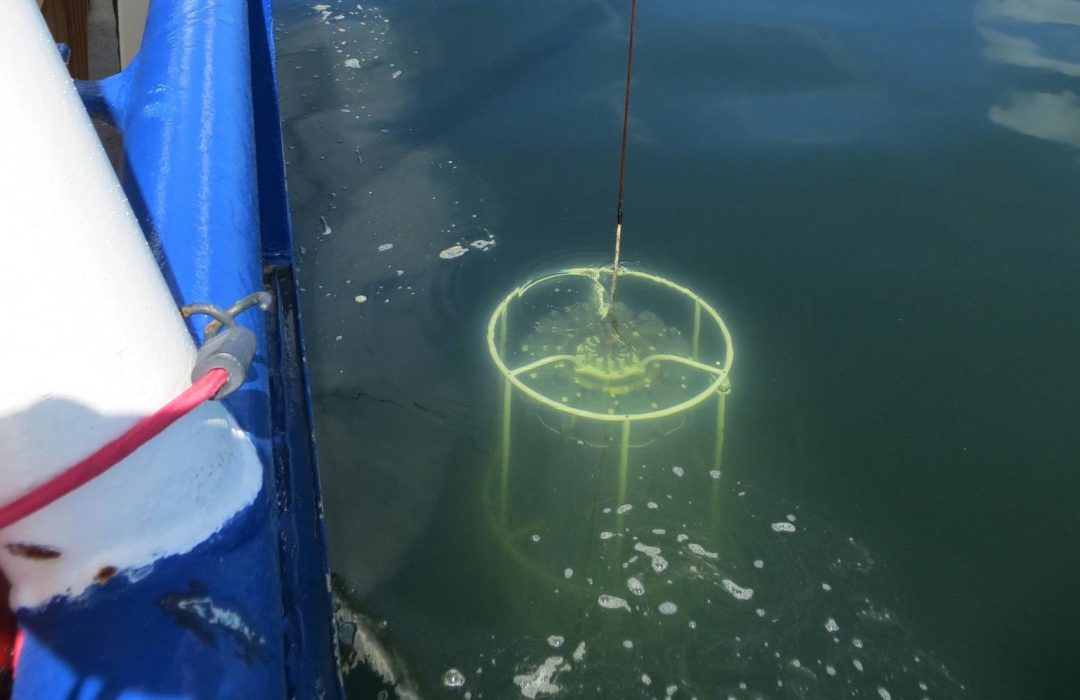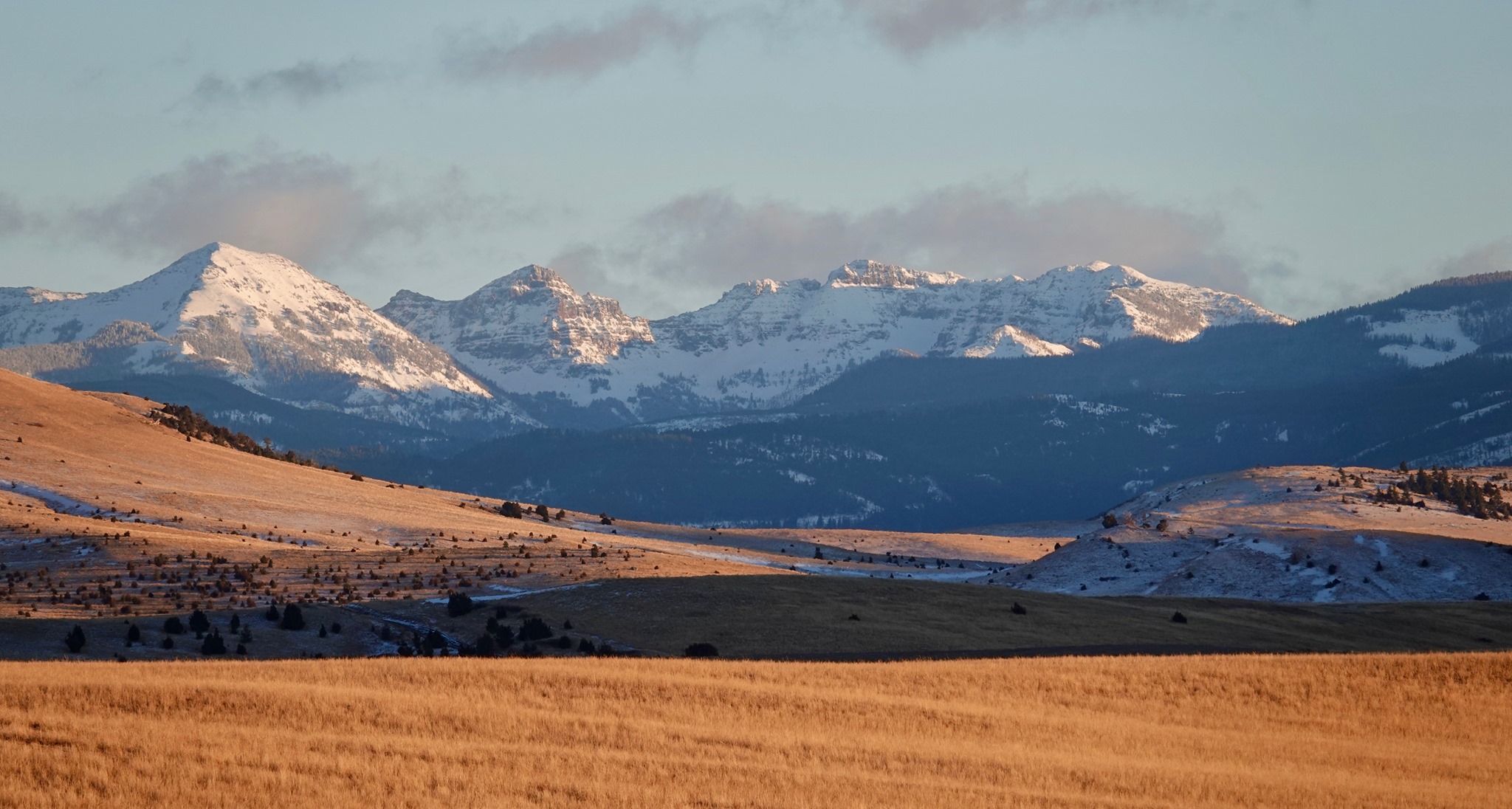REU Program

Microbial mats at Grand Prismatic Springs Yellowstone - Credit - E. Boyd
Microbiology of Low Oxygen Ecosystems (MLOxE) REU at Montana State
Program Dates - May 27, 2025 - August 2, 2025
Overview and Who Should Apply
Microbiology of Low Oxygen Ecosystems (MLOxE) at Montana State is a summer research program supported by the National Science Foundation’s Research Experience for Undergraduates (REU) program. Microorganisms living in the absence of oxygen influence some of Earth's most important environmental processes (e.g., nutrient, toxin, and greenhouse gas cycling), play essential roles in human health, and can provide insight into how life first arose and diversified on this planet. Participation in MLOxE REU will prepare students to help solve pressing scientific problems by understanding the critical role of these microorganisms in ecosystems. Student projects may involve diverse low oxygen systems, such as the microbial habitats of the human body, terrestrial hot springs, or marine oxygen minimum zones. Students will be paired with faculty advisors in the Departments of Microbiology and Immunology, Land Resources and Environmental Sciences, Chemistry and Biochemistry, or Chemical and Biological Engineering. Research by MLOxE faculty (see list below) covers three core areas: 1) Microbial Interactions, 2) Metabolism and Physiology, and 3) Community and Ecosystem Function.

Molecular analysis of mammalian gut microbiome - Credit -S. Walk
We seek students who have a passion for science and for applying science to the benefit of their communities and who would enjoy being part of a diverse group of peers who share these passions. All interested students are welcome and encouraged to apply. We particularly encourage applications from American Indian and Alaska Native students, other Underrepresented Minority (URM) groups, or schools with limited research opportunities.
Why Apply?
During the 10-week program, students will conduct lab, field, or computational research and participate in a range of activities. Activities will include team-building field trips, social outings with the REU cohort, educational and career development workshops, and networking designed to empower students to pursue science as a career and to build supportive professional and community relationships. Students will take advantage of these activities while spending the summer in the unique and beautiful landscape of southwestern Montana.
Support for Participants
Participants will receive a stipend of $7000 for the summer. An additional $2000 per student will be provided to faculty advisors to help support student research activities. Students will also receive compensation for travel to and from Bozeman. On-campus housing and 100 on-campus meals will also be provided.
What to Expect
Each student will spend the summer conducting research in the lab of an MLOxE faculty advisor. Students will indicate their interest in potential advisors (see list below) during the application process and will be assigned to an advisor based on a suitable match between student interests and faculty expertise. Once at Montana State, students will spend the first week settling into their labs and getting to know their REU cohort and the Bozeman area. During this early period, students will receive safety training and will work with their faculty advisor and labmates to outline a summer research project. During the remainder of the 10-week program, students will conduct lab, field, or computational research (30-40 hrs per wk) and participate in weekly meetings with the Program Directors, faculty advisors, and invited speakers. These meetings will involve REU student presentations of research findings and ongoing project plans; faculty seminars on research related to microbiology; and group discussions and training exercises focused on writing and oral communication, networking, research ethics and bias, science career paths, and the process of applying for graduate and professional programs. Students will have the opportunity to participate in numerous social activities, including a field trip into Yellowstone National Park led by an expert in Native American history and the Yellowstone ecoregion. At the end of the summer, students will prepare a written report of their project and present their work to students and faculty during a poster symposium.
Why Montana State University?

Sampling of oceanic hypoxic zone - Credit- F. Stewart
The MLOxE REU program is housed and administered through the Department of Microbiology and Immunology at MSU. MSU has unique expertise in environmental microbiology, notably in identifying, culturing, and physiologically characterizing Bacteria and Archaea from low oxygen environmental biofilms. Much of this expertise stems from MSU's long history of studying thermal microbial biofilms, facilitated by close proximity to and established partnerships with Yellowstone National Park. This expertise has since expanded to include research groups focusing on environmental systems ranging from deep-sea sediments, diverse animal microbiomes, soils, and extreme environments of ice and polar regions. This work is strengthened by unique resources, including MSU's Center for Biofilm Engineering (CBE). The CBE is recognized as an international resource for advancing basic knowledge, technology, and education required to understand, control and exploit biofilm processes, including in low oxygen, host-associated environments. Many of the MLOxE REU advisors are CBE affiliates and have access to an array of CBE-maintained shared resources for visualizing and characterizing microbial biomolecules, cells, and communities. MSU is also home to the Thermal Biology Institute, which has for decades been a source of protocol development for sampling aquatic biofilm habitats for biogeochemical and microbial characterization.

Outside Bozeman -Credit- F. Stewart
Montana State University is also unique in its commitment to empowering Native American students. MSU acknowledges, honors and respects the Native American custodians on whose traditional territories the University now stands and whose historical relationships with the land continue today. Recognized as a top university for Native students, MSU prioritizes a culture of diversity and inclusion through its longstanding partnerships with Montana’s Tribal Colleges, Native American Studies Department, extensive Native American Education and Outreach Projects, and new $20M American Indian Hall. These resources are designed to increase Native students’ transfer into and success in STEM disciplines through greater campus inclusivity, enhanced student support, and respectful research and educational collaborations between our institution and Tribal communities. A core goal of this REU program is to help students pursue projects that involve or benefit local stakeholders, including Tribal communities.
How to Apply
Applications for summer 2025 can be submitted online starting on December 1, 2024. Applications can be submitted through this site: https://etap.nsf.gov/award/7204/opportunity/10117.
A completed application consists of 1) the online application form, 2) an up-to-date unofficial transcript, and 3) two letters of recommendation, all of which should be submitted by the end of day (11:59 pm, Mountain Time) on February 13, 2025. The application asks applicants to provide the names and email addresses of TWO individuals who can provide letters of recommendation and to identify five potential faculty advisors. For information about possible REU advisors, please see the list of MLOxE Faculty Advisors below.
Questions?
If you have questions please contact Program Coordinator Zoe Pratte ([email protected]) or Program Director Dr. Frank Stewart ([email protected]).
MLOxE REU Faculty Advisors
Diane Bimczok (http://www.montana.edu/mbi/directory/1819499/diane-bimczok) studies how the gastric system, specifically the low oxygen environment of the stomach, responds to infection by the bacterium that causes ulcers. Ulcers are a widespread disease with significant implications for human wellbeing. REU projects in her lab will likely focus on molecular interactions.
Eric Boyd (https://www.montana.edu/mbi/directory/1523925/eric-boyd) studies microbial life in early Earth analog low oxygen environments to provide understanding into how life arose and diversified on our planet. His work focuses on how lithogenic substrates generated through water-rock interaction have shaped and continue to shape the distribution, diversity, and evolution of microbial life. Target environments include low oxygen hot springs, subglacial environments, the deep subsurface, and the surfaces of rocks and minerals. These systems are explored using molecular, physiological, and biochemical approaches to understand how microbes interact with their physical and chemical environment, a goal that is central to understanding basic processes of how microbes influence and transform ecosystems.
Ross Carlson (http://www.biofilm.montana.edu/people/faculty/carlson-ross.html) studies how metabolic systems become structured, function, and interact, particularly in the context of biofilms. Biofilms are communities of microorganisms that live in a polysaccharide/protein matrix on various surfaces. They play major roles in chronic infectious disease and in almost all natural and engineered environments, including wastewater treatment systems and on most surfaces in aquatic systems (including medical devices in the human body). The properties of biofilms are defined by networks of interacting cells and metabolisms, many of which operate without oxygen. He seeks to deconstruct these processes to understand their implications for health and ecosystem function, potentially to engineer systems for human benefit.
Dan Colman (https://www.montana.edu/mbi/directory/2040482/daniel-colman) studies the diversity, physiology, and evolution of microbial life and its relationship to geochemistry. His research spans diverse habitats, but targets hydrothermal and volcanic environments, including the unique low oxygen microbial ecosystems of Yellowstone. An overarching theme is to characterize the processes that allow microbes to persist and thrive in these systems and to use this knowledge to understand potentially similar processes early in Earth’s history. His study of these systems blends the fields of geochemistry, physiology, and genomics and involves time both in the field and at the lab bench.
Mari Eggers (https://www.montana.edu/mbi/directory/1929900/margaret-eggers) is an environmental health scientist who works with Tribal and rural communities on microbial and chemical contamination of water sources and on drinking water security. She has 25 years of experience teaching and mentoring Native American STEM students, initially teaching science at a Montana Tribal College and currently teaching environmental health at MSU. She is active in multiple MSU organizations serving underrepresented minority students in STEM, including MSU’s Council of American Indian Programs, comprised of staff, faculty and administrators serving Native students.
Alyssa Evans (https://www.montana.edu/mbi/directory/2420314/alyssa-evans) studies host-virus interactions of arthropod-transmitted orthobunyaviruses. These mosquito-borne viruses can cause severe neurological consequences in hosts, primarily in human children. However, the mechanisms by which orthobunyaviruses mediate neurological change are not well understood. She combines molecular virology, genetics, immunology, in vitro human neuronal cell models, and mouse models to understand how genetic differences in orthobunyaviruses influence host immune responses and neurological outcomes.
Matthew Fields (https://www.montana.edu/mbi/directory/1524078/matthew-fields) directs the Center for Biofilm Engineering at Montana State. His research focuses on microbes of various biofilm environments, including in coal beds and other subsurface habitats where oxygen is scarce. Understanding microbial diversity and processes in these systems is relevant to how important chemicals such as hydrocarbons in oil and coal move through the environment, interact with biological processes, and ultimately can be harnessed for human use or degraded to improve environmental conditions.
Michelle Flenniken (https://plantsciences.montana.edu/directory/faculty/1524085/michelle-flenniken) studies the molecular mechanisms underlying host-virus and host-microbe interactions in agriculturally important systems, including honey bees (Apis mellifera). Bee-associated microbial communities include functionally diverse participants, including those adapted to low oxygen biofilms. Potential projects may involve determining mechanisms of honey bee antiviral defense; monitoring and discovery of microbes associated with colony losses; understanding the influence of the bee microbiome, metabolome, and transcriptome on host immune and behavioral response.
Christine Foreman (https://foremanresearch.com) studies life in icy environments using a combination of field and laboratory studies, as well as approaches ranging from the single-cell to the community level. Her research group is interested in understanding how the environment controls the composition of microbial communities and how, in turn, those microbes regulate whole ecosystem processes such as nutrient and organic matter cycling. Ongoing research examines carbon flux through microbial communities, with the long-term goal of improving predictions of carbon fate (metabolism to CO2, sequestration into biomass, long-term storage in ice) in the context of a changing environment. Additionally, they are interested in physiological adaptations to life in extreme environments, as extremophiles are natural resources for the discovery of pigments, biosurfactants, novel enzymes and other bioactive compounds of industrial relevance.
Roland Hatzenpichler (https://chemistry.montana.edu/directory/1943087/roland-hatzenpichler) studies how microbes interact with their environment, and how these interactions impact both humans and the ecosystem. His work spans a diversity of habitats, almost all of which are characterized by a lack of oxygen. These include hot springs and deep-sea sediments. He has particular expertise in state-of-the-art imaging techniques to characterize active microbes. These techniques, and the insights gleaned from their use, can help better prioritize efforts to identify the microbes most important to human and ecosystem health.
Laura K. Jennings (https://www.montana.edu/mbi/directory/2553287/laura-jennings) studies bacterial factors that influence infection outcomes in the priority pathogen Pseudomonas aeruginosa. P. aeruginosa infections are of significant concern due to their severity in immunocompromised patients and high levels of antibiotic resistance, making treatment challenging. Her research focuses on how environmental conditions, particularly low oxygen, drive bacterial heterogeneity and impact antibiotic resistance/tolerance. In bacterial biofilm aggregates and at infection sites where oxygen is limited, P. aeruginosa populations differentiate into subpopulations with varying drug resistance. Using molecular biology and microbiology techniques, the Jennings Lab seeks to mechanistically understand how these environmental gradients and bacterial epigenetic changes like DNA methylation shape infection dynamics. This work is crucial for developing innovative strategies to combat drug-resistant bacterial infections.
Patrick R. Secor (https://www.montana.edu/mbi/directory/2553333/patrick-secor) studies interactions between bacteriophages (viruses that infect bacteria) and their bacterial hosts in low oxygen environments, such as those found at sites of infection or the gut. His research examines how bacteriophages influence bacterial physiology and biofilm formation under oxygen-limited conditions and how these interactions impact infection dynamics and treatment outcomes. Dr. Secor’s lab employs molecular biology, microbiological, immunological, and next-generation sequencing techniques to explore how bacteriophage-bacteria interactions can be harnessed to disrupt biofilms and enhance therapeutic strategies. REU projects in his lab may involve investigating how oxygen availability affects bacteriophage replication dynamics, identifying bacteriophage-derived tools for combating antibiotic-resistant bacterial infections, or studying the role of bacteriophages in shaping microbial communities in hypoxic infection sites.
Frank Stewart (https://www.montana.edu/mbi/directory/2257528/frank-stewart) studies the microbiology of ocean systems that are devoid of oxygen. These systems, called oxygen minimum zones, are expanding under climate change and play critical roles in how oceans regulate the supply of nutrients and greenhouse gases. These systems are dominated by microorganisms, many of which remain un-described but likely play key roles in regulating the chemistry of the oceans. His research also explores microbes in the low oxygen mucus environments of aquatic animals, such as on corals and fishes. Understanding microbial diversity and function in these systems can help to craft strategies for managing animal resources.
Jovanka Voyich (http://www.montana.edu/mbi/directory/1524709/jovanka-voyich) studies the physiology and immune response associated with bacterial disease, focusing specifically on infections by the pathogen Staphylococcus aureus (Staph). Staph is an opportunistic pathogen with the capacity to live in environments without oxygen, including wounds. It is also known for its resistance to antibiotics and is therefore a serious risk to human health, as Staph infections can cause death. Understanding how Staph interacts with the low oxygen wound environment is essential for strategies to prevent or reverse infection.
Seth Walk (https://www.montana.edu/mbi/directory/1524711/seth-walk) studies how microbes interact, both with each other and with the human body, to affect health. He focuses on diverse systems, including the microbial ecosystems that live in the human gut. These microbes live in oxygen-depleted niches and play essential roles. For example, they stimulate or suppress our immune system, regulate the uptake of food and nutrients and therefore influence weight gain and obesity, and even influence our mood and behavior. His research seeks to understand the factors influencing the diversity of these microbes, their movement among humans, and their effects on the body. A project in the lab explores to what extent SARS-CoV-2, the causative agent of COVID-19, can be detected in wastewater after it has passed through the human gut. This work has direct implications for developing improved strategies to detect and monitor COVID outbreaks.
Blake Wiedenheft (https://www.montana.edu/mbi/directory/1524738/blake-wiedenheft) studies viruses that infect bacteria (bacteriophage). He seeks to understand the mechanisms phage use to manipulate their hosts and the counter-defense systems microbes use to protect themselves from infection, including the CRISPR system of adaptive microbial immunity. Projects in the lab span environments and scales of organization, from communities in the acidic hot springs of Yellowstone to the proteins used by microbes to withstand oxygen-induced stress.
Qing Yan(https://plantsciences.montana.edu/directory/faculty/2200358/qing-yan) studies the molecular mechanisms of beneficial plant-microbe interactions, specifically how beneficial bacteria inhibit fungal pathogens and promote plant growth. One of the research projects focuses on antimicrobial metabolites produced by the beneficial bacteria Pseudomonas spp.. He is interested in understanding how the beneficial bacteria regulate the biosynthesis of antimicrobial metabolites in response to different environmental cues (biotic factors such as interaction with other microorganisms and abiotic factors such as temperature fluctuations) and how to use synthesized microbial community to provide a stable plant growth promotion with the presence of pathogens.
Carl Yeoman (https://yeomanlab.com/team/) studies the reproductive- and gastrointestinal-tract systems of humans, domestic
and wild ungulates, and a variety of other animals. His research often integrates
field work, wet-lab bench/basic microbiology, and/or the application of molecular
techniques and bioinformatics. Current projects in the Yeoman lab focus on microbial
modulation of the ruminant immune system, the detoxification of plant toxins in wild
ruminants (deer, elk, moose, mountain goat, bighorn sheep, and bison), and the microbial
and metabolite modulators of human reproductive and gynecological health. Dr. Yeoman
presently serves as Montana INBRE’s Bioinformatics and Biostatistics director.
Thank you so very much!!
